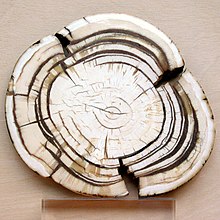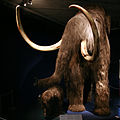Woolly mammoth
| Woolly mammoth Temporal range: Late Pleistocene to Recent
| |
|---|---|

| |
Prehistoric
| |
| Scientific classification | |
| Kingdom: | |
| Phylum: | |
| Class: | |
| Order: | |
| Family: | |
| Genus: | |
| Species: | M. primigenius
|
| Binomial name | |
| Mammuthus primigenius Blumenbach, 1799
| |
The woolly mammoth, also called the tundra mammoth, is an extinct species of mammoth. This animal is known from bones and frozen carcasses from northern North America and northern Eurasia with the best preserved carcasses in Siberia.
This mammoth species was first recorded in (possibly 150,000 years old) deposits of the second last glaciation in Eurasia. They were derived from steppe mammoths (Mammuthus trogontherii).[1]
Adaptations
Woolly mammoths had a number of adaptations to the cold, most famously the thick layer of shaggy hair, up to 50 cm (20 in) long, for which the woolly mammoth is named. They also had far smaller ears than modern elephants; the largest mammoth ear found so far was only a foot (30 cm) long, compared to six feet (1.8 m) for an African elephant. They had a flap of hairy skin which covered the anus, keeping out the cold.
Their teeth were also adapted to their diet of coarse tundra grasses, with more plates and a higher crown than their southern relatives. Their skin was no thicker than that of present-day elephants, but unlike elephants they had numerous sebaceous glands in their skin which secreted greasy fat into their hair, improving its insulating qualities. They had a layer of fat up to 8 cm (3 in) thick under the skin which, like the blubber of whales, helped to keep them warm.
Woolly mammoths had extremely long tusks - up to 16 feet (5 m) long - which were markedly curved, to a much greater extent than those of elephants. It is not clear whether the tusks were a specific adaptation to their environment, but it has been suggested[who?] that mammoths may have used their tusks as shovels to clear snow from the ground and reach the vegetation buried below.
-
skeleton
-
skin
-
skull
-
head
-
young
Extinction
While most woolly mammoths died out at the end of the Pleistocene (12,000 years ago), a small population survived on St. Paul Island, Alaska, up until 6000 BC [2], while another remained on Wrangel Island, located in the Arctic Ocean, up until 1700 BC. Possibly due to their limited food supply, these animals were a dwarf variety, thus much smaller than the original Pleistocene woolly mammoth. However, the Wrangel Island mammoths should not be confused with the Channel Islands Pygmy Mammoth, Mammuthus exilis, which was a different species.
Frozen carcasses


Preserved frozen remains of woolly mammoths, with much soft tissue remaining, have been found in the northern parts of Siberia. This is a rare occurrence, essentially requiring the animal to have been buried rapidly in liquid or semi-solids such as silt, mud and icy water which then froze. This may have occurred in a number of ways. Mammoths may have been trapped in bogs or quicksands and either died of starvation or exposure, or drowning if they sank under the surface. Though judging by the evidence of undigested food in the stomach and seed pods still in the mouth of many of the specimens, neither starvation nor exposure seem likely. The maturity of this ingested vegetation places the time period in autumn rather than in spring when flowers would be expected.[2] The animals may have fallen through frozen ice into small ponds or potholes, entombing them. Many are certainly known to have been killed in rivers, perhaps through being swept away by river floods. In one location, by the Berelekh River in Yakutia in Siberia, more than 9,000 bones from at least 156 individual mammoths have been found in a single spot, apparently having been swept there by the current.[citation needed]
In 1977, the well-preserved carcass of a 7 to 8 months old baby woolly mammoth, named "Dima", was discovered. This carcass was recovered from permafrost on a tributary of the Kolyma River in northeastern Siberia. This baby woolly mammoth weighed approximately 100 kg at death and was 104 cm high and 115 cm long. Radiocarbon dating determined that Dima died about 40,000 years ago. Its internal organs are similar to those of living elephants, but its ears are only one-tenth the size of those of an African elephant of similar age.[1]
In the summer of 1997, a Dolgan family named Jarkov discovered a piece of mammoth tusk protruding from the tundra of the Taymyr Peninsula in Siberia, Russia. In September/October 1999 this 20,380 year old carcass and the surrounding sediment were flown to an ice cave in Khatanga, Taymyr Autonomous Okrug. In October 2000, the careful defrosting operations in this cave began with the use of hairdryers to keep the hair and other soft tissues intact.[3]
To date, thirty-nine preserved bodies have been found, but only four of them are complete. In most cases the flesh shows signs of decay before its freezing and later desiccation. Stories abound about frozen mammoth corpses that were still edible once defrosted, but the original sources indicate that the corpses were in fact terribly decayed, and the stench so unbearable that only the dogs accompanying the finders showed any interest in the flesh.[4]
In addition to frozen corpses, large amounts of mammoth ivory have been found in Siberia. Mammoth tusks have been articles of trade for at least 2,000 years.[citation needed] They have been and are still a highly prized commodity. Güyük, the 13th century Khan of the Mongols, is reputed to have sat on a throne made from mammoth ivory,[citation needed] and even today it is in great demand as a replacement for the now-banned export of elephant ivory.
Genetics
Since there is a known case in which an Asian elephant and an African elephant have produced a live (though sickly) offspring, it has been theorized that if mammoths were still alive today, they would be able to interbreed with Indian elephants. This has led to the idea that perhaps a mammoth-like beast could be recreated by taking genetic material from a frozen mammoth and combining it with that from a modern Indian elephant.

Scientists hope to retrieve the preserved reproductive organs of a frozen mammoth and revive its sperm cells. However, not enough genetic material has been found in frozen mammoths for this to be attempted. The complete mitochondrial genome sequence of Mammuthus primigenius has been determined, however [5]. The analysis demonstrates that the divergence of mammoth, African elephant, and Asian elephant occurred over a short time, and confirmed that the mammoth was more closely related to the Asian than to the African elephant. As an important landmark in this direction, in December 2005, a team of German, UK & American researchers were able to assemble a complete mitochondrial DNA of the mammoth, which allowed them to trace the close evolutionary relationship between mammoths and the Asian elephant. African elephants branched away from the woolly mammoth around 6 million years ago, a moment in time intriguingly close to that of the similar split between chimps and humans.
On July 6, 2006 it was reported that scientists, using the latest genetic techniques, determined that a gene called Mc1r, extracted from a 43,000-year old woolly mammoth bone from Siberia, caused woolly mammoths to have dark brown coats or blond hair.[6] [7]
Woolly mammoths and cryptozoology
There have been occasional claims that the woolly mammoth is not actually extinct, and that small isolated herds might survive in the vast and sparsely inhabited tundra of the northern hemisphere. In the late nineteenth century, there were, according to Bengt Sjögren (1962), persistent rumours about surviving mammoths hiding in Alaska.[8] In October 1899, a story about a man named Henry Tukeman detailed his having killed a mammoth in Alaska and that he subsequently donated the specimen to the Smithsonian Institution in Washington, D.C. However, the museum denied the existence of any mammoth corpse and the story turned out to be a hoax.[9] Sjögren (1962) believes the myth was started when the American biologist C.H. Townsend traveled in Alaska, saw Eskimos trading mammoth tusks, asked if there still were living mammoths in Alaska and provided them with a drawing of the animal.
In the 19th century, several reports of "large shaggy beasts" were passed on to the Russian authorities by Siberian tribesman, but no scientific proof ever surfaced. A French charge d´affaires working in Vladivostok, M. Gallon, claimed in 1946 that in 1920 he met a Russian fur-trapper that claimed to have seen living giant, furry "elephants" deep into the taiga. Gallon added that the fur-trapper didn't even know about mammoths before, and that he talked about the mammoths as a forest-animal at a time when they were seen as living on the tundra and snow (Sjögren, 1962).
In legends
A mammoth possibly appears in an ancient legend of the Kaska tribe in British Columbia, The Bladder Headed Boy.[10] The story tells how the boy in the title killed the animal, and was rewarded by being made the first chief of his people. The animal is described as a "huge shaggy beast that roamed the land long ago," but is also said to steal meat and eat people, suggesting that the creature in the story could have become embellished over the years.
References
- ^ a b Harington, C.R. (1995). Yukon Beringia Interpretive Centre - Wooly Mammoth. Retrieved from http://www.beringia.com/02/02maina2.html Cite error: The named reference "Harington" was defined multiple times with different content (see the help page).
- ^ E. W. Pfizenmayer was one of the scientists who recovered and studied the mammoth that was found at the river Berezovka in the early 1900s. In his book, Siberian Man and Mammoth, he says about the mammoth: "Its death must have occurred very quickly after its fall, for we found half-chewed food still in its mouth, between the back teeth and on its tongue, which was in good preservation. The food consisted of leaves and grasses, some of the latter carrying seeds. We could tell from these that the mammoth must have come to its miserable end in the autumn."[1]
- ^ Mol, D. et al. (2001). The Jarkov Mammoth: 20,000-Year-Old carcass of a Siberian woolly mammoth Mammuthus primigenius (Blumenbach, 1799). The World of Elephants, Proceedings of the 1st International Congress (October 16-20 2001, Rome): 305-309. Full text pdf
- ^ E.g. William R. Farrand's article in Science 133 [March 17, 1961]:729-735
- ^ Krause J. et al. (2006). Multiplex amplification of the mammoth mitochondrial genome and the evolution of Elephantidae. Nature 439, 724-727 (9 February 2006)
- ^ Rompler H. et al. (2006). Nuclear Gene Indicates Coat-Color Polymorphism in Mammoths. Science 313 (5783), 62. Online abstract
- ^ Morelle, R. (2006). Gene reveals mammoth coat colour. BBC News: http://news.bbc.co.uk/2/hi/science/nature/5154892.stm
- ^ Sjögren, Bengt. Farliga djur och djur som inte finns, Prisma, 1962
- ^ Henry Tukeman: Mammoth's Roar was Heard All The Way to the Smithsonian http://www2.tpl.lib.wa.us/v2/NWROOM/MORGAN/Tukeman.htm
- ^ http://www.folklore.bc.ca/Bladderheadboy.htm





